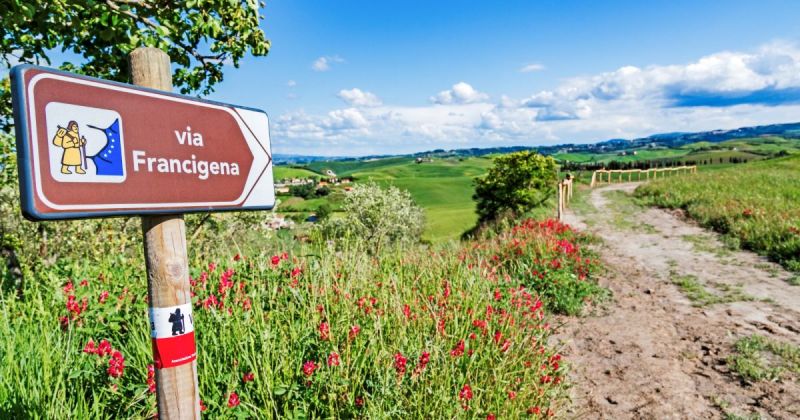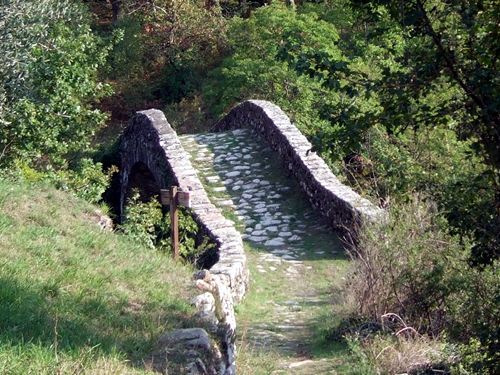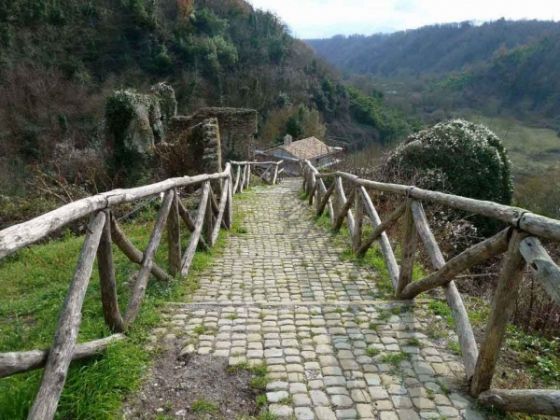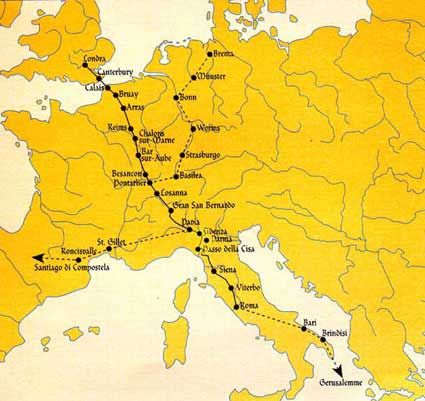The Via Francigena was a holy mediaeval pilgrimage road to Rome and can still be walked today.
With the help of European Union funding, Italy is trying to emulate the phenomenal success of the Camino Francés to Santiago de Compostela by promoting the Via Francigena as a long distance footpath to Rome. Having recently walked 2,200 kms from my home near London to Rome, ten years after completing a similar walk from Walsingham to Santiago de Compostela, it is sad to report that despite valiant local work, the Via Francigena has some way to go before it is much more than a long distance obstacle course. The primary obstacle in Italy is way-marking, or the absence of consistent sign posts at critical turning points.Anyone can walk the Camino Francés from the Pyrenees to Santiago without a map or guide; the way is so well marked that it is instinctively easy to follow. Not so for many stretches of the Via Francigena, where even with a guidebook and a compass it is all too easy to take the wrong turning. The problems and challenges in Italy vary according to region and province. The descent from the Grand St Bernard Pass into the Val d’Aosta is perfectly way-marked and, although a tough stage, it is a pleasure to walk. Thereafter in the rest of Piedmont, the signs become less helpful and, after leaving the Alpine foothills and entering Lombardy, they become even more erratic and in some places they peter out altogether. Hardly a day went by when I didn’t encounter some problem with finding the way. On one occasion, south of Siena, I fell in with a Dutchman from Amsterdam, Kees Venema, who had also walked all the way from his home, and while we walked together for a few hours talking we missed marks or took wrong turnings on three occasions. The three-volume Lightfoot Guide to the Via Francigena, which I took with me, at times had up to five pages of directions for just one stage.
There are too often showpiece roadside signs, boasting that the Via Francigena passes through this or that town or village, then nothing at all in a wooded area or on a remote hillside track. Indeed the absence of way-marks in woods, where it is very hard to get a good bearing, seems to be a specialty of the Via Francigena. The woods before reaching the delightful riverside town of Ponte a Cappiano near Lucca have a multitude of junctions and forks where at best you have to guess your way. Daniele at the bar in the piazza said simply: “I hear the same complaint from everybody.” The woods before and after the beautiful Tuscan hilltop town of Monteriggioni north of Siena laid similar traps – sometimes with a way-mark on the inside of a turning, so that you had either to have eyes in the back of your head or else turn backwards to catch the next mark.
This is really the lament for the whole of the Via Francigena. 90 per cent of the way-marks are excellent and well placed, but the problem is that they are not always joined up. Ponte a Cappiano illustrates another reason why the Via Francigena still has some way to go. European funds partly paid for the reconstruction of the former pilgrim hostel on the covered bridge. The night I stayed there it was full of migrants and refugees, but there was no meal on offer and only a bare kitchen. The food shop was shut and there was nowhere in town to eat. It was ice cream for supper. That would never happen on the Camino Francés. “The sad reality is that too much of the European funding has gone into roadside signs which show off the Francigena, but not into hostels and better way-marks, which actually help the pilgrim,” says Danilo Parisi, who operates a ferry service for pilgrims crossing the River Po. “In 2008 they spent some ?2 million on those road signs but they are not much help if you are trying to find your way on foot.”
The ferry from Corte S. Andrea to Calandasco near Piacenza was put back into service in 1998 and Parisi has kept a close and affectionate eye on the pilgrim route ever since. He has a book which records every pilgrim crossing since 1998. Numbers have increased year by year, but still only reach just over 300 per year, a mere trickle compared to the thousands who trek to Santiago. Most of those who cross the Po on Parisi’s launch have started in Lausanne or at the Grand St Bernard. Only a handful have come all the way from Canterbury, and a few more from the Netherlands and Germany. There was no record in his book of anyone previously walking from London. “Only about one in every ten starts from home,” said Parisi. “The Camino Francés in Spain has added affordable accommodation every year,” he said. “In Italy we have not done enough, and too often pilgrims are offered a room in a parish house with a cold shower and are given a key and told the nearest pizzeria is two kilometres away – that is not my idea of providing pilgrim hospitality.” Another major problem with the Via Francigena in Italy is that the official way frequently leads walkers onto, along and across busy roads.
There are times as well when the official way takes such a circuitous route to avoid roads that walkers, wary of losing their way in woods yet again, take the road route in any case. For this reason, many choose to walk down long stretches of the Via Cassia on the last 200 kms to Rome, braving sometimes heavy traffic. The entry to Rome itself is a disgrace – you have no choice but to walk on the Via Cassia. But for all of its travails and challenges, the Via Francigena is a magnificent walk. The way broadly follows the route of pilgrims from the Middle Ages and in particular that taken by Sigeric, archbishop of Canterbury, who left a stage by stage account of his journey back from Rome in 990-992.
I started from my home town in Coggeshall in north Essex and walked the Essex Way into London from where I set out with the express intention of reversing history and travelling from St Paul’s Cathedral to St Peter’s Basilica. It took me a total of 75 days, including eight rest days. I crossed Kent on the North Downs Way, ferried from Dover to Calais, and then headed for Arras and from there I broadly followed Sigeric’s route – walking to Rheims, Besançon and over the Jura mountains to Lausanne in Switzerland. I came over the Alps at the Grand St Bernard Pass, at the top walking on the old Roman road which bears deep wheel ruts from centuries of use. There are similar ancient sections further on where you touch the footfall of past pilgrims, including a delightful stretch of paved Roman basalt road south of Lake Bolsena. After the Alps there are many more hills ahead – three quarters of Italy is hills – and some steep climbs on narrow paths over sometimes broken ground.
The Via Francigena passes through the cities of Aosta, Vercelli, Pavia, Fidenza, Lucca, Siena and Viterbo, and takes in some of the most scenic Tuscan towns – the emerging and receding views of S. Miniato and S. Gimignano are timeless. It meanders through the beautiful Val d’Orcia where the rolling hills of Tuscany, with their landmark farmhouses, cypress trees, vineyards, cornfields and wooded groves, are best savoured at three miles an hour. A large wolf bounded across my tracks in southern Tuscany, and several snakes slithered across my path, but the biggest menace throughout Italy was from unleashed farm dogs. Walking through Italy at the height of a hot summer I rarely had problems finding food and water. Every small hamlet still has a drinking water fountain, and most still have a café or bar.
France may be easier to traverse on foot – it is flatter and there are more footpaths and small country roads to walk down – but the French have made only a partial commitment to La Voie Francigène; it is hardly way-marked at all in the north of France. As for shops and bars, they are long gone, and often the only source of water in the lost villages of the French interior is the tap in the cemeteries. Those seeking their Pilgrim Testimonium need only start at Aquapendente, some 160 kms from Rome, which can be reached from there comfortably in a week. Only mad dogs and Englishmen come all the way from Essex. Brian Mooney is a prize-winning journalist and author. He was a Reuters correspondent in Rome from 1977-1980. He is writing a book on his walk – A long Way for a Pizza
by
Bryan Mooney




























